
Birgus latro, the coconut crab is the larger cousin to the Coenobita species. They are physically very similar. Birgus latro abandons it’s shell protection as a juvenile and can grow quite large. An adult can have a claw span of 90 cm/35 in. Not appropriate for a pet.
COMMON NAMES: Coconut Crab, Robber Crab; French Crabe de cocotier
Latin Origins: latro means robber
TRADITIONAL NAMES: Kaveu / Unga ‘Onu < Kaveu (RR), Unga Puku‘ara (MG), Unga Kaveu (AT AK RK), Toromimi < Unga Kaveu / Unga (MK), Ūngākave‘u / Toromimi < Ūngākave‘u (MT), Kaveu (TS TW PK), Unga Koveu (MH)
GLOBAL DISTRIBUTION: NATIVE islands only: Mauritius – Tuamotu; n. to s.Japan, s. to New Caledonia. (Not in Australia, nor Papua New Guinea)
COOK ISLANDS STATUS: Native; Land, breed in ocean; Coastal, preferring dense forest cover, within a few kilometres of the ocean.
Cook Islands Distribution:
http://cookislands.bishopmuseum.org/distribution.asp?id=7038
KEY FEATURES: The largest land-crab, deep blue or tinged red. Thorax is wing-like, with a central “wishbone”. The left claw (chela) is massive, the right smaller. Two pairs of walking legs (periopods), and smaller hind pair of appendages with terminal claws. FEMALES have 3 large feathery pleopods under the abdomen to support teh egg mass.
GENERAL NOTE: Fully terrestrial, drinking water – including seawater. Their “lungs” are the gill chambers, which are aerated by a paddle-like remnant of the gill. They drown if kept in seawater. Mating occurs near the sea and involves the male pushing the female onto her back and using his 5th periopod to place the sperm-sac (spermatophore) over the gonopore at base of the walking legs. After this the female lives within 100 metres of the sea to regularly moisten herself with seawater. 1-2 weeks after mating teh female extrudes the eggs past the sperm-sac so they are fertilized and holds them in a mass with her abdomenal pleopods. The eggs take 3-6 weeks to mature. The young (as zoea) are spawned from the eggs into the water around the first and last quarters. The zoea takes 3-6 weeks to go through 4-5 zoea stages and form an ampbibious stage called a glaucothoe. The benthic, shrimplike glaucothoe finds a minute shell and after 3-4 weeks it migrates ashore. After about 4 weeks of living around the high tide mark, it transforms into a juvenile crab, which continues to use a gastropod shell for 1-2 years, and lives very secretively in burrows. Smallest without a shell had TL of 4mm, probably all have discarded the shell by TL 6mm. Crabs burrow and moult 2-4 times a year up to TL 30mm (immatures), and, when adult, they moult once a year. They are solitary and usually nocturnal, especially where human activity is frequent. They are omnivorous, commonly eating the fallen fruit of Pandanus and the Coconut Palm. They use their main claws to pull back the husk at the end which was formerly attached to the palm. When the eyes are exposed they pierce the soft-eye with a walking-leg claw, expand the hole with the small pincer on the third walking-leg, and finally enlarge the hole with the main pincer. The process takes several days. The Coconut Crab is esteemed as food. Unfortunately, it is easily over-harvested, because of its complex life-cycle and slow growth rate.
Vouchers & References
Vouchers:
Rarotonga: fieldspecimen, s.Muri home of Gwen Welland, Oct/2005, dead, blue, 72mmTL (~30 years old), G.McCormack with ID as Birgus latro. Atiu: field-specimen, College collection, 10/2000, ID GMcC. Pukapuka: fieldspecimen+photo, 2/2004, G.McCormack with ID as Birgus latro.
References:
Special Reference: Yaldwyn & Wodzicki 1979;
Citation Information:
McCormack, Gerald (2007) Cook Islands Biodiversity Database, Version 2007.2. Cook Islands Natural Heritage Trust, Rarotonga. Online at http://cookislands.bishopmuseum.org.
From http://cookislands.bishopmuseum.org/species.asp?id=7038
A description from Alcock 1905

BIRGUS, Leach.
Birgus, Leach, Trans. Linn. Soc. XI., 1815, p. 337: Desmarest, Consid, Gen, Crust., 1825, p. 180: Milne Edwards, Hist. Nat. Crust., II., 1837, p. 244: DeHaan, Faun, Japon. Crust., 1849 p. 203; Dana, U. S. Expl. Exp., Crust., pt. I., 1852, p. 435: Stimpson, Proc. Acad. |Nat. Sci. Philad. (1858) 1859, p, 232: Boas, Vid, Selsk. Skr., 6 Raek., naturvid. og math. Afd. I., 2, 1880, p. !91 ; Henderson, Challenger Anomura, 1888, p, 49: Stebbing, Hist. Crust., 1893, p. 156: Ortmann, in Bronn’s Thier Reich, Malacostraca, p. 1147.
Carapace contracted anteriorly as in Coenobita, but greatly expanded across the branchial regions where its breadth equals its length, well calcified everywhere, though most strongly so in the gastric region. Rostrum prominent.
Eyestalks subcylindrical: ophthalmic scales juxtaposed, hidden beneath the vertically deflexed subrostral end of the carapace.
Antennular peduncle nearly as long as the carapace: the flagella compressed, truncated at tip; the upper very much longer and stouter than the lower.
Antennal peduncle compressed: the acicle fused with the 2nd joint: the flagellum stout, but very long.
The external maxillipeds are in contact at base: the exopodite of the 1st maxillipeds is non-flagellate, those of the 2nd and 3rd have a very short, non-segmented flagellum. The endopodite (palp) of the 1st maxillae is nonflagellate.
Both chelipeds are massive, the left more so than the right; all the joints are short, broad, and heavy: the fingers move obliquely but much nearer to the horizontal than to the vertical.
The 2nd and 3rd pairs of legs are extremely stout; the 4th and 5th pairs are cheliform, the 4th being twice as long as and many times more bulky than the 5th which are tucked up within the gill-chambers.
Abdomen shorter than the carapace, broad, straight, symmetrical simply flexed beneath the thorax: all the terga are well calcified, the 2nd 3rd, 4th, and 5th being broad overlapping plates with small subsidiary platelets (pleura) on either flank: the 6th tergum and the telson are very much reduced in size, are widely separated from the 5th, and are quite ventral in position. In the male the only abdominal appendages present are those that flank the telson, which, like the telson, are rudimentary, though symmetrical: in the female, in addition, there are large hairy biramous appendages on the left side of the 2nd, 3rd, and 4th abdominal somites.
The gills, which are phyllobranchiae and are 14 in number on either side arranged as in Pagnrus, are very small, and respiration is chiefly effected by the lining-membrane of the capacious gill-chambers, which is greatly thickened and has its surface enormously increased by abundant arborescent growths.
The genus Birgus is represented by a single species, the well-known Birgus latro, which, among the tropical islands of the Indo-Pacific, has a range of about 180* of longitude, from the islands in the vicinity of Madagascar on the west, to the Sandwich Is. and Paumatu (Low) Archipelago on the east.
Birgus, like the Coenobites, is a fruit-eating—but, on occasion, carnivorous (scavenging) and cannabalistic—” land-crab,” and is a denizen of the jungle, though it is said to visit the shore, and the females must periodically seek the sea to hatch-off their eggs.
It is essentially a Paguroid (and a Coenobite), being singular only in its gigantic size and in its habits. Its size is such as to render a portable habitation an inconvenience, if not an impossibility, and the requisite protection for its abdomen is supplied by a re-development of the terga, the first five of which are as perfect as those of Pylocheles. Again, by reason of its being an air-breather, its gills, like those of Coenobita, are of only subsidiary importance, and respiration is effected—and herein lies the chief difference, consequent on a more finished adaptation to a perfectly independent life on land, between Birgus and Coenobita—by an enormous development not only of the gill-chambers themselves, but also of their lining membrane.
The habits of this remarkable hermit-crab have attracted the attention of many travelers, from the time of Master Francis Fletcher, the chaplain and historian of Drake’s famous voyage of circumnavigation, up to the present day. In Willey’s Zoological Results, part V., p. 590, Mr. L. A. Borradaile has given a list of the principal observations that have been published.
It is to Willey and Borradaile also that we owe the knowledge that the young of Birgus leaves the egg as an (aquatic) zoaea resembling other known Pagurine zoaeas.
Carapace transversely scored and rugose with the edges of the ridges burred with very short bristles. Rostrum stout, acute, often surpassing the eyes.
Eyestalks not, or little, surpassing the penultimate joint of the antennal peduncle: the latter peduncle not very much longer than the basal joint of the antennular peduncle.
Chelipeds and 2nd— 4th legs rugose, the rugae of the carpi and propodi being fringed with short bristles and with dark-coloured corneous granules and denticles: on the fingers of the chelipeds and 4th pair of legs, and on the stout dactyli of the 2nd and 3rd pair of legs, the black corneous tubercles are very numerous and are often spiniform or squamiform.
Usually the legs of the two sides are symmetrical, those of the 2nd pair being the longest and exceeding those of the 3rd pair by the dactylus and the larger cheliped by about half the dactylus; but sometimes in the female the 2nd left leg is shortened and the 3rd right leg lengthened. The coxae of the 5th legs are not produced to any special extent.
Colours of fresh spirit specimens: exposed dorsal surface of body and appendages rich tortoise-shell, ventral surface bluish-purple. In old spirit specimens the colours fade a good deal.
The adult male is much larger than the female. In the largest male of the Museum collection the carapace measures 187 mm. (about 7 2/3 inches) in extreme length and the same across the branchial regions.
Geographical distribution: from the Comoro Islands (off the coast of Mozambique), Madagascar, Reunion, Mauritius, Seychelles and Chagor Is. (Diego Garcia), to the Andamans (S. Sentinel I.) and Nicobars, then through the East Indian Archipelago to the Liu Kiu Is., and thorugh Polynesia to Paumaut Archipelago, Fanning, And Sandwich Is.
Within the limits of British India, Birgus latro is known to occur only in the Nicobars, and at S. Sentinel I., a wester outlier of the Andaman group. In 1889 it was very abundant at S. Sentinel, where the officers of the “investigator” observed it crouching under fallen trunks and between the buttress-roots of large trees during the heat of the day, but becoming active at times of cloud and rain, and towards nightfall. Individuals carried away captive were noticed to be nocturnal and cannibalistic, and one was see deliberately drinking rain water. The creature though powerful is sluggish an unaggressive, and uses its long 2nd pair of legs rather than it’s nippers in offence.

Reference
CATALOGUE OF THE INDIAN DECAPOD CRUSTACEA IN THE COLLECTION OF THE INDIAN MUSEUM. PART II. ANOMURA. FASCICULUS I. PAGURIDES. BY A. ALCOCK, M.B., LL.D., F.RS., CLE. 1905
The Coconut Crab: Aspects of Birgus latro biology and ecology in Vanuatu, 87 98. Canberra, Australian Center for International Agricultural Research. S. Lavery and D.R. Fielder 1991
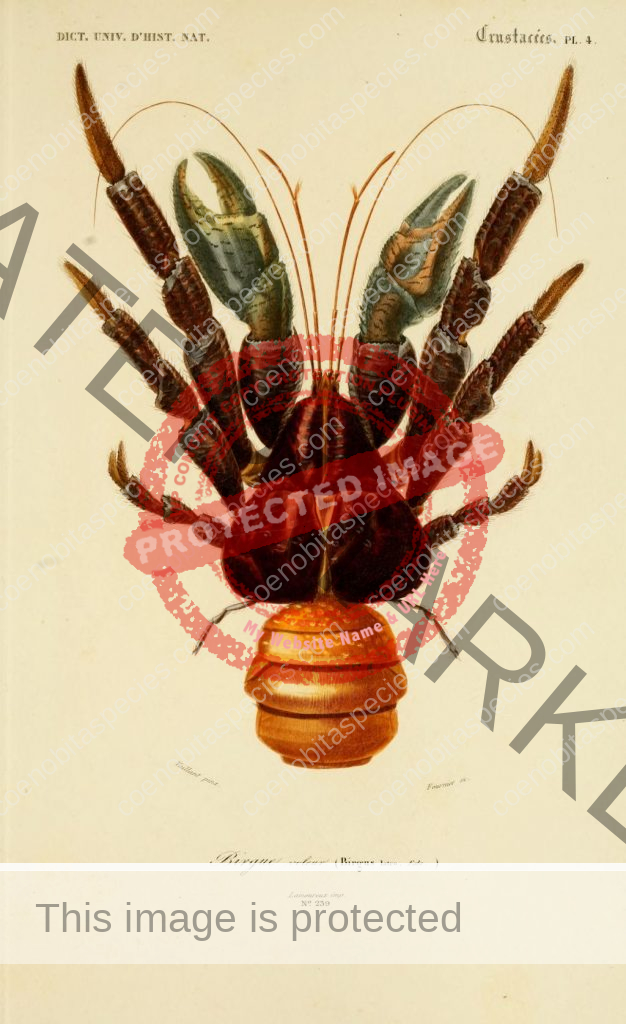

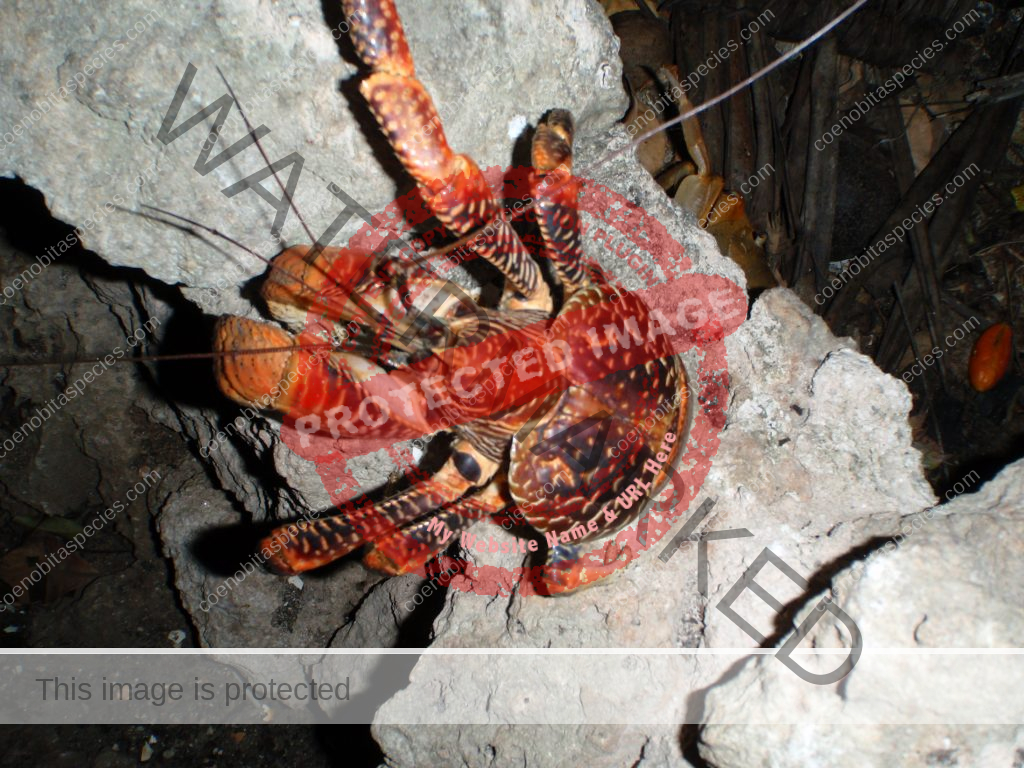
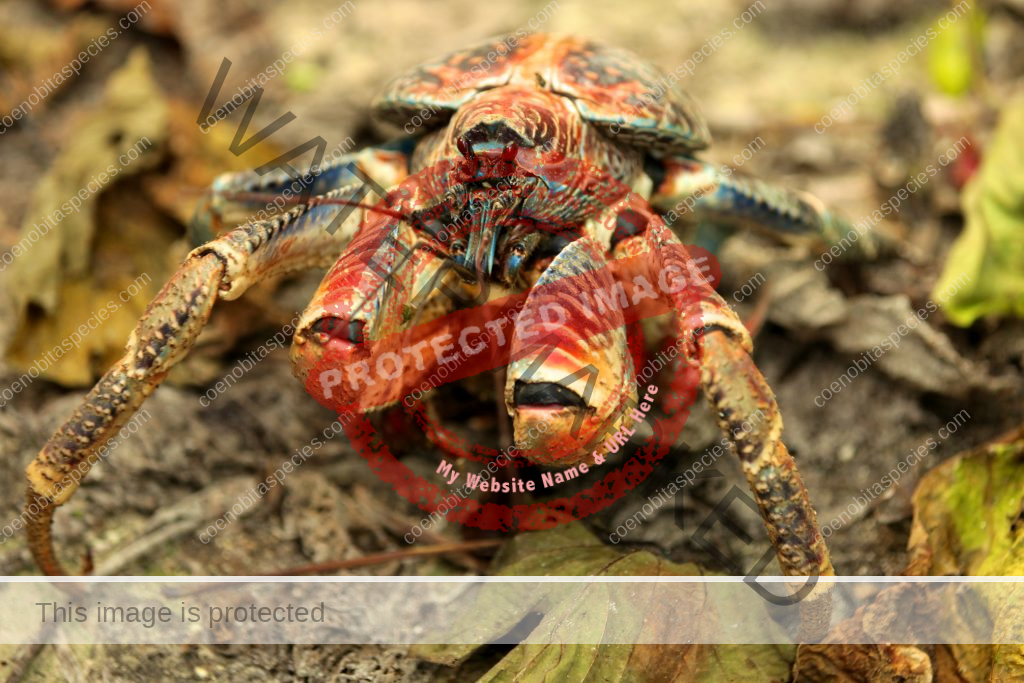
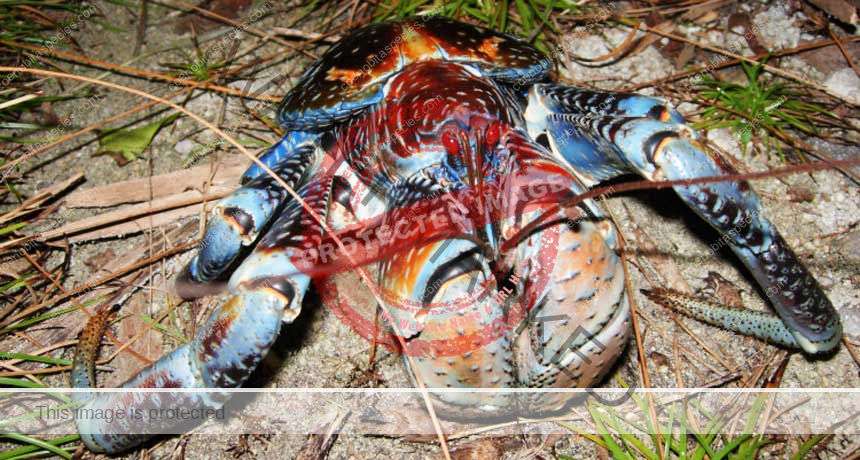
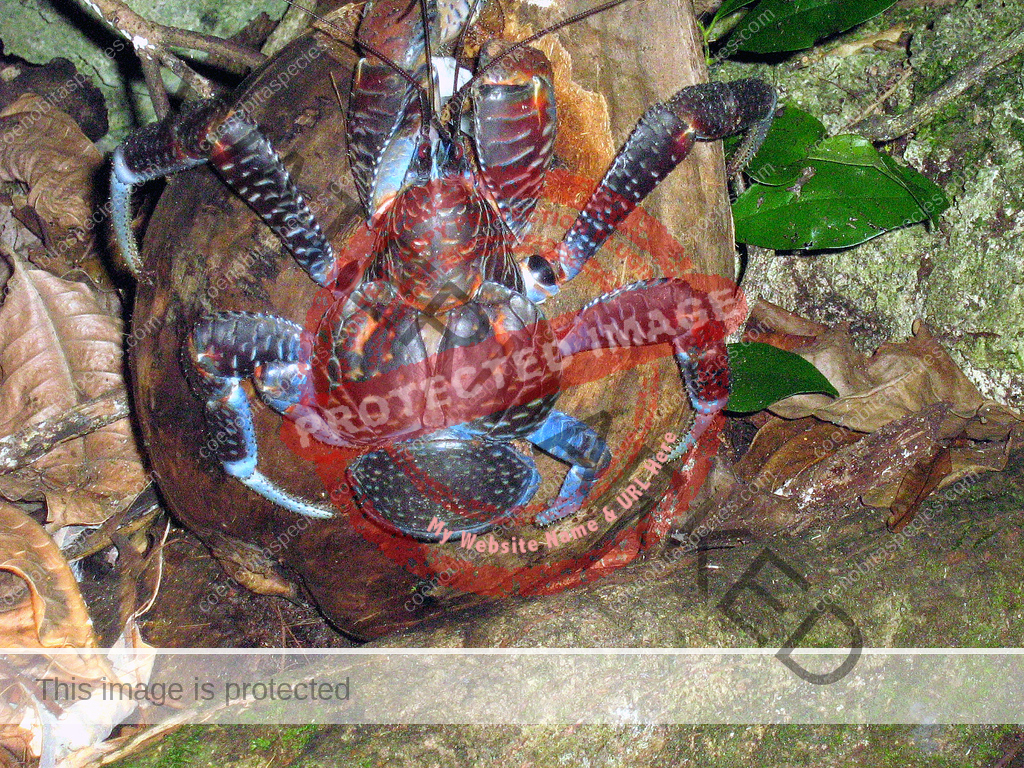
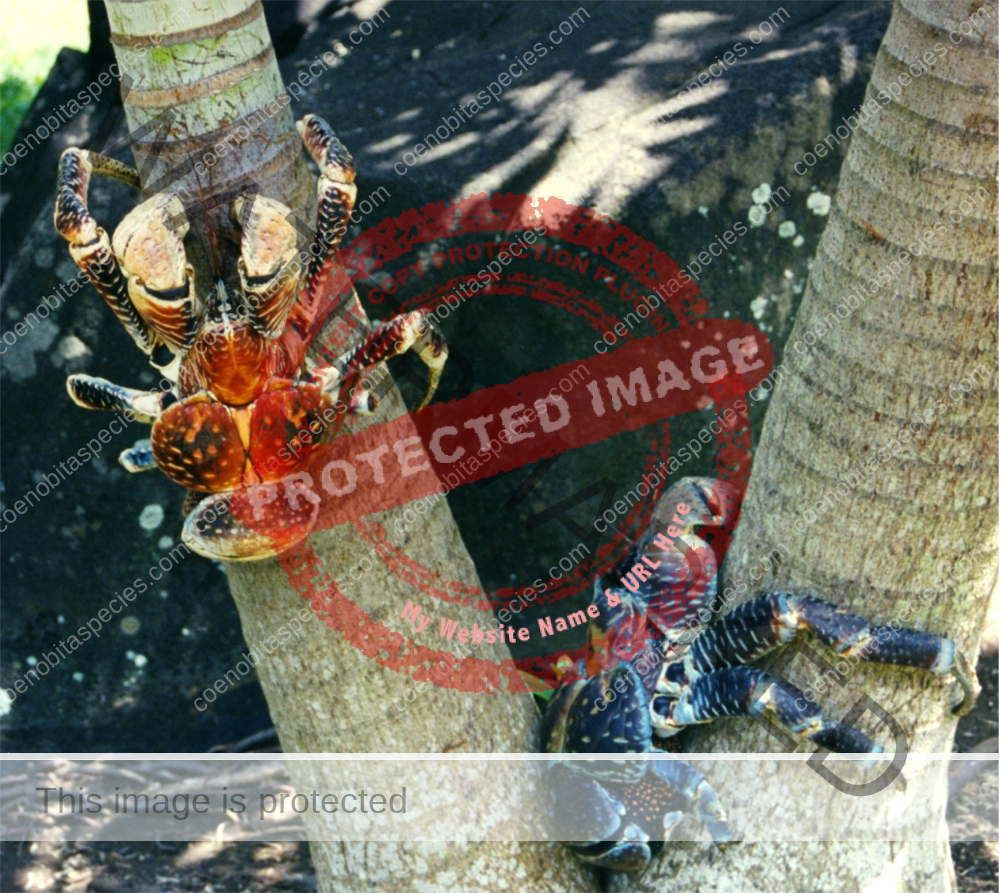
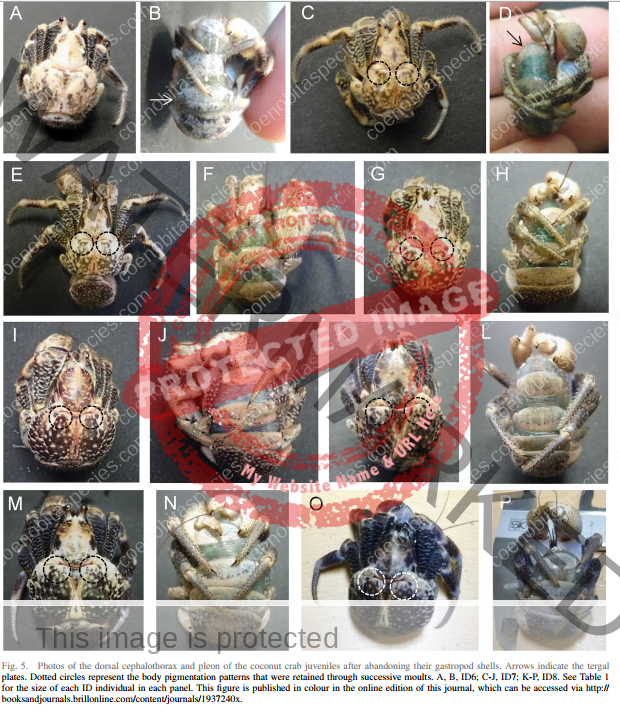

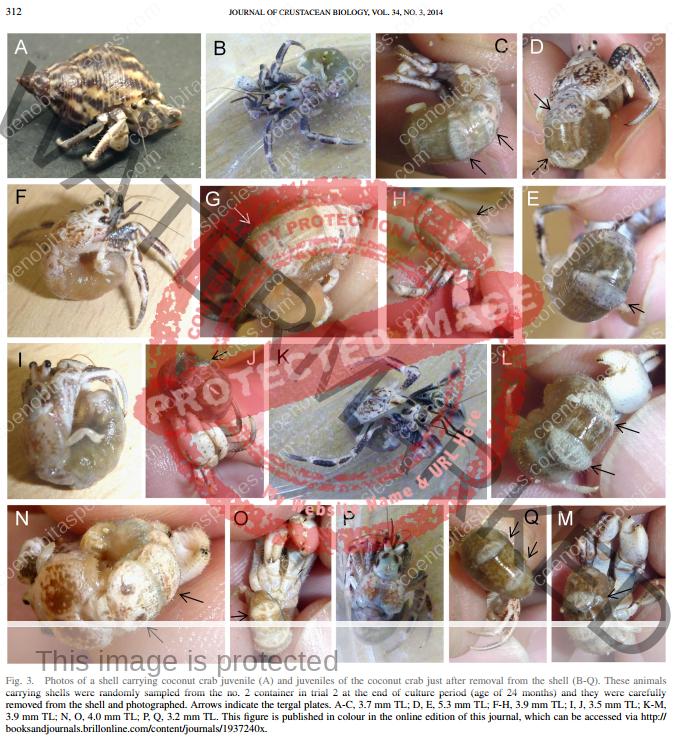
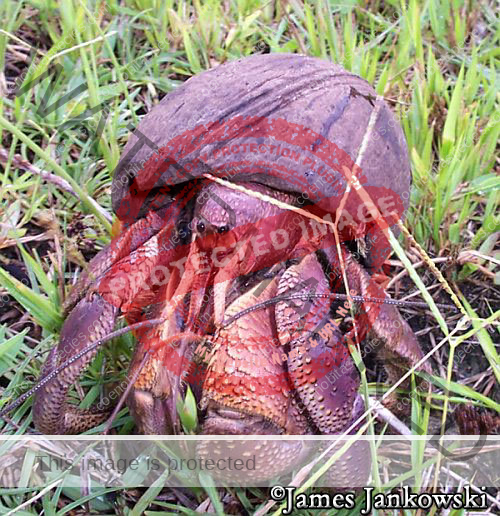
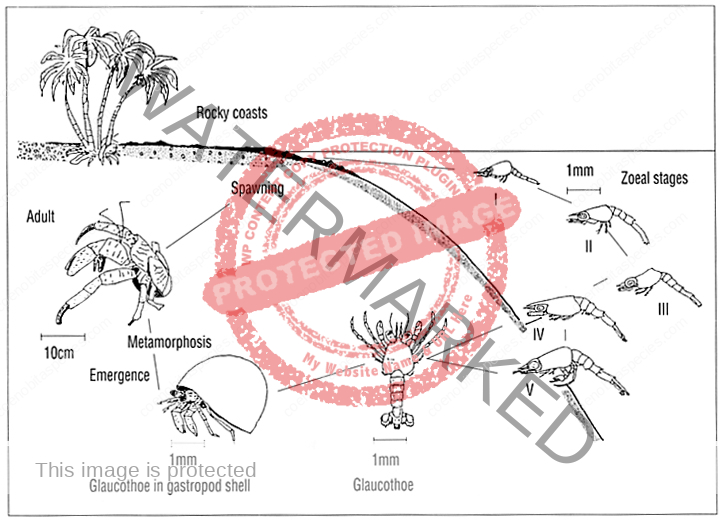
Lifecycle of Coenobitidae

